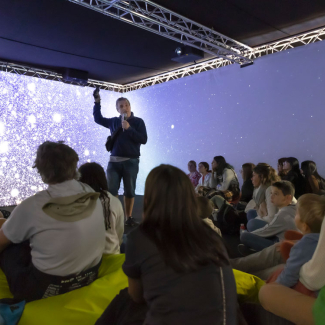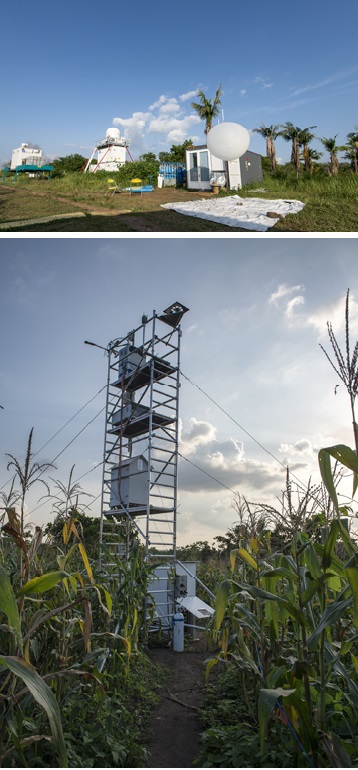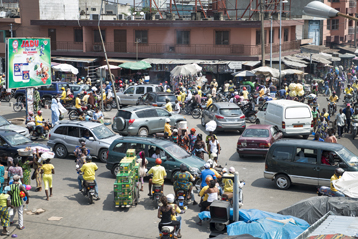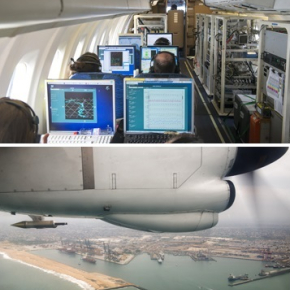
DACCIWA : better understanding the impacts of pollution in West Africa
With an exploding population, massive urbanization and uncontrolled deforestation, West Africa is faced with major change, which could see anthropogenic 1 pollution increase threefold between 2000 and 2030. What impact will this have on public health and ecosystems, as well as on the weather and climate? This is the issue addressed by the European DACCIWA program, which brings together 16 partners, including CNRS, Université Toulouse III – Paul Sabatier, Université Pierre et Marie Curie, Université Paris Diderot and Université Blaise Pascal - Clermont-Ferrand II. It will eventually make it possible to improve weather and climate forecasting in this little-studied region. With a major airborne and ground-based measurement campaign carried out in early summer, the program has delivered its first results, showing in particular that a large proportion of the pollution comes from open landfills.
- 1emitted by human activities.
The DACCIWA program, funded by the European Union and coordinated by the Karlsruhe Institute of Technology in Germany, focuses on the connections between weather, climate and air pollution in West Africa, from Ivory Coast to Nigeria. For the first time, it has enabled scientists to carry out a complete study of the impacts of natural and anthropogenic emissions on the atmosphere of the region and on human health, thanks to a comprehensive field campaign in June and July 2016.
The air over the Gulf of Guinea is a unique, complex mixture of various gases and aerosols 2
, of both natural and human origin, including monsoon winds laden with sea salt, Saharan winds carrying dust, forest and domestic fires, open landfills in towns, large numbers of oil tankers off the coasts, oil rigs and an aging car population. At the same time, the multiple layers of clouds that develop in this environment have a major effect on the weather and climate. However, atmospheric composition and its effect on cloud formation and dispersal have never been studied in this region. As a result, weather and climate models are still incomplete with regard to aerosol-cloud interactions in a chemical environment as complex as that of the Gulf of Guinea.
Among the resources implemented in the DACCIWA program, three research aircraft have been used to monitor how air pollution from ports and large coastal cities (Abidjan, Accra, Lomé, Cotonou, Lagos) affects inland areas. Major resources have also been deployed on the ground: for two months, three heavily instrumented sites, in Ghana, Benin and Nigeria, continuously measured clouds and many of the physical phenomena that play a part in their formation and dispersal. In addition, weather balloons were released several times a day all across the region, while ad hoc measurements of urban air pollution as well as health surveys were carried out in Abidjan (Ivory Coast) and Cotonou (Benin).
Initial results show, surprisingly, that a large part of the pollution is organic in origin, caused by continuous low-temperature burning in open landfills. The particles produced reduce the amount of solar radiation reaching the ground, modifying daytime changes in temperatures, wind and cloud, as well as atmospheric dynamics.
From now until 2018, the researchers will analyze the data, supplemented with satellite observations, with the aim of proposing an explanatory mechanism for the interaction between atmospheric chemistry, aerosols, formation and dispersal of low clouds, radiation budget and precipitation. The goal is to improve weather, climate and air quality models, which will support environmental policies for sustainable development of the region, and provide useful information about the health consequences of air pollution.
To find out more: www.dacciwa.eu
These images of the field campaign (together with others) are available in high definition (on request from veronique.etienne@cnrs-dir.fr).

This ATR 42, belonging to the Service des Avions Français Instrumentés pour la Recherche en Environnement (CNRS/Météo-FranceFrance/CNES), is one of three research aircraft that took part in coordinated work over the countries of the Gulf of Guinea (together with the Falcon 20 of the German Space Agency (DLR) and the British Antarctic Survey's Twin Otter). It carried over two tons of material for in situ and remote sensing measurements. During the airborne campaign the chemical composition of the atmosphere upwind and downwind from pollution sources (ports and urban areas) was measured, and its impact on cloud properties was studied. The campaign also provided information about regional pollution sources such as biomass fires in the southern hemisphere and desert dust. Highly localized sources were characterized during these operations (gas flares, industrial sites, ports) as well as natural emissions from vegetation. The image on the right shows the aircraft flying over the port of Lomé (Togo).

The 'supersite' at Savé (Benin). The image on the left shows a weather balloon (in the foreground) and a rainfall radar (building with a dome). The Laboratoire d'Aérologie (CNRS/Université Toulouse III – Paul Sabatier) has in particular installed a UHF radar and an instrumented tower for meteorology and atmospheric chemistry (image at right), and used a lightweight drone to measure air temperature and humidity.

Road traffic is one of the major pollution sources in the region's cities (shown here, Abidjan, in Ivory Coast, where urban pollution was measured). However, it is far from being the only source of pollution: surprisingly, a large proportion of the pollution comes from open landfills.

Observatory/SEDAC, Columbia University
Map of population density in the region studied. From Ivory Coast to Nigeria, a huge coastal megalopolis 2000 km long is emerging. What effect will it have on air quality, weather and climate?
The French laboratories and departments involved in this program are:
- Unité de Biologie Fonctionnelle et Adaptative (BFA, CNRS/Université Paris Diderot): assessment of toxicity of samples of particles collected in Abidjan and Cotonou (Armelle Baeza).
- Centre National de Recherches Météorologiques (CNRM, CNRS/Météo-France): contribution to the aerosol measurement payload on board the ATR 42.
- Institut Pierre Louis d'Epidémiologie et de Santé Publique (IPLESP, Inserm/UPMC): data collection in hospitals in Abidjan and Cotonou, carried out in collaboration with the BFA, in order to analyze the impact of air quality on health (Isabella Annesi-Maesano).
- Laboratoire d'Aérologie (LA, CNRS/Université Toulouse III – Paul Sabatier): coordination of the field campaign at the instrumented supersite at Savé (Benin) and carrying out of two air pollution measurement campaigns at urban sites in Ivory Coast and Benin (Céline Mari).
- Laboratoire de Météorologie Physique (LaMP, CNRS/Université Blaise Pascal): in charge of the ATR 42 payload for in situ and remote sensing measurement of chemical constituents, aerosol and cloud properties, and atmospheric radiation and dynamics (Alfons Schwarzenboeck).
- Laboratoire Atmosphères, Milieux, Observations Spatiales (LATMOS, CNRS/UPMC/UVSQ): coordination of the airborne campaign conducted from Lomé and weather forecasting in support of flight operations (Cyrille Flamant).
- Laboratoire de Météorologie Dynamique (LMD, CNRS/École Polytechnique/UPMC/ENS de Paris): atmospheric chemistry forecasting in support of flight operations, in coordination with LA.
- Observatoire Midi-Pyrénées (OMP, CNRS/IRD/Université Toulouse III – Paul Sabatier/Météo-France): creation of the DACCIWA Operation Center website by OMP's data department, bringing together and making available 'quick looks' of observations carried out in the field, as well as analyses from the various forecasting centers involved in the project.
- le Service des Avions Français Instrumentés pour la Recherche en Environnement (SAFIRE, CNRS/Météo-France/CNES): operation of the French research aircraft.
The DACCIWA project brings together 16 partners from six countries: in Germany, the Karlsruhe Institute of Technology and the German Space Agency (DLR); in the United Kingdom, the European Centre for Medium-Range Weather Forecasts, the Met Office, as well as the Universities of Leeds, York, Reading and Manchester; in Switzerland, ETH-Zürich; in Ghana, Kwame Nkrumah University of Science and Technology Kumasi; in Nigeria, Obafemi Awolowo University; in France, CNRS , Université Toulouse III – Paul Sabatier, Université Pierre et Marie Curie, Université Blaise Pascal - Clermont-Ferrand II, Université Paris Diderot. Université Félix-Houphouët-Boigny in Abidjan (Ivory Coast) and Université d'Abomey-Calavi in Cotonou (Benin) are also associated with the program.
- 2airborne solid and liquid particles.


